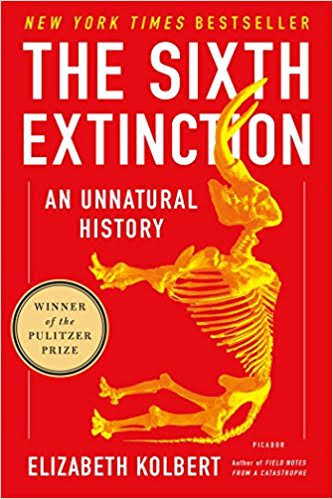"The Sixth Extinction" by Elizabeth Kolbert

Above: "The Sixth Extinction." Elizabeth Kolbert - 269 Pages
He has dubbed the current reshuffling of the earth's biota a "mass invasion event." It is, he has written, "without precedent" in the planet's history."
I completed reading this Pulitzer Prize winning book today.
Kolbert chronicles in thirteen very well written and readable chapters what we know about the five major extinctions that have occurred since life first appeared on the planet 500 million years ago.
Some extinctions were caused by global warming (Ordovician - earliest land plants). The end Cretaceous extinction was caused by a comet hitting the Yucatan area of Mexico. Atmospheric debris kept sunlight and temperatures diminished for thousands of years. This is the extinction that wiped out the dinosaurs.
Mankind, according to Kolbert (and the many scientists she uses as support) is the cause of the ongoing sixth extinction.
In Chapter Ten, "The New Pangaea," Kolbert discusses the process of "remixing" the world's flora and fauna. The process, which began slowly, along the routes of early human migration, has, in recent decades, accelerated to the point where in some parts of the world, non--native plants now outnumber native ones. During any given twenty-four hour period, it is estimated that ten thousand different species are being moved around the world just in ballast water. Kolbert quotes Anthony Ricciardi, a specialist in introduced species at McGill University. He has dubbed the current reshuffling of the earth's biota a "mass invasion event." It is, he has written, "without precedent" in the planet's history."
Kolbert asks the reader to note that the drifting apart of the continents, which was deduced from the fossil record, is now being reversed - another way in which humans are running geologic history backward and at high speed. "Think of it as a souped-up version of plate tectonics, minus the plates," Kolbert says.
By transporting Asian species to North America, and North American species to Australia, and Australian species to Africa and European species to Antarctica, we are, in effect, reassembling the world into one enormous supercontinent - what biologists sometimes refer to as the New Pangaea.
Chapter Eight. "The Forest and the Trees." Kolbert joins forest ecologist Miles Silman, who teaches at Wake Forest University, at his tree plots in Manu National Forest (one of the world's great biodiversity "hot spots") in eastern Peru.
From the top of a 12 thousand foot mountain at descending elevations down to four thousand feet, Silman has 17 tree plots down to four thousand feet. Each plot contains different species of trees based on what that particular elevation allows.
Silman's experiment shows that as the earth warms, some species "race" up the mountain to seek the climate they are losing. These species crowd out other species slower to move.
While global warming and global cooling have happened many times in the epochal past, the putative human caused global warming is happening at a much compressed rate. This will no doubt, according to Silman, lead to the extinction of many tree species unable to keep up by moving to a more hospitable climate.
There's much much more. It was mankind that probably "did in" the Neanderthals and the big mammals extant at the end of the last ice age. There is an excellent chapter on ocean acidification and the destruction of the coral reefs. Coral reefs, by the way, have proliferated and later died in several of the previous extinctions.
In her final chapter Kolbert discusses the future. She notes that mankind, while being a catalyst for extinctions, has shown initiative in attempting to reverse them. The California Condor, once down to less than twenty individuals, is now at over 400 in population.
Optimists say that via the initiative of mankind and science, much can be reversed.
Pessimists point to dire consequences, where mankind, dependent on a balanced eco system to survive, is doomed. Not much can be done. And, considering the fact that the earth remains dynamic in an ongoing creative and destructive process, cataclysm at some point is inevitable, mankind's impact or not.
Optimists retort that this is a reason to accelerate our efforts to relocate mankind on other planets.
One scientist notes, "Don't worry, as long as we keep exploring, humanity is going to survive."
There are no easy answers... and Kolbert doesn't try to provide any. This is a provocative book to get you thinking about what, if anything, you can or should do to alter your own life considering the ongoing sixth extinction. Note: I clipped a copy for my back pocket of the only footnote in the book: *A useful mnemonic for remembering the geologic periods of the last half-billion years is: Camels Often Sit Down Carefully, Perhaps Their Joints Creak (Cambrian-Ordovician-Silurian-Devonian-Carboniferous-Permian-Triiassic-Cretaceous). The mnominic unfortunately runs out before the most recent periods: the Paleogene, the Neogene, and the current Quaternary.